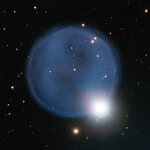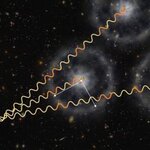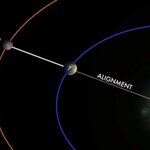Space

A small icy object within the rings of Saturn may be a new moon, according to interpretation of images taken with Cassini's narrow angle camera on April 15, 2013 which show disturbances at the very edge of Saturn's A ring -- the outermost of the planet's large, bright rings.
One of these disturbances is an arc about 20 percent brighter than its surroundings, 750 miles (1,200 kilometers) long and 6 miles (10 kilometers) wide. Scientists also found unusual protuberances in the usually smooth profile at the ring's edge. Scientists believe the arc and protuberances are caused by the…

The universe is big, as you can imagine. Even our galaxy is almost beyond comprehension. But measure it we do, at least as best we can.
The most reliable method for making astronomical distance measurements is to use geometry - the 186-million-mile diameter of Earth's orbit is used to construct a baseline of a triangle, much as a land surveyor would use.
If a target star is close enough, it will appear to zigzag on the sky during the year as a reflection of Earth's orbit about the Sun. This technique is called parallax. Astronomical parallax works reliably for stars within a few hundred…

When he opened the sixth seal, I looked, and behold, there was a great earthquake, and the sun became black as sackcloth, the full moon became like blood, and the stars of the sky fell to the earth - Revelation 6:12-14
We've only had a few doomsday events come and go in 2014 but a new one arrives April 15th. No, it isn't the IRS, though that is doomsday for American wallets.
Sure, to you and me a lunar eclipse is no big deal, but to a lot of other people we live in super-important times and so a lunar eclipse must become a "blood moon", which sounds sufficiently creepy enough to…

Most stars with masses similar to that of our Sun will end their lives as white dwarfs; small, very dense, and hot bodies that slowly cool down over billions of years. On the way to this final phase of their lives the stars throw their atmospheres out into the space and create planetary nebulae, colorful glowing clouds of gas surrounding the small, bright stellar relics.
An captured by ESO's Very Large Telescope (VLT), shows the remarkably round planetary nebula Abell 33, located about 1,500 light-years from Earth. A round appearance is uncommon. Usually something - for example, the way…

This week we get Mars in opposition and a bright red planet, but next week is a treat for space enthusiasts also. In the early morning hours of April 15th, north Americans can expect the moon to look a little different.
A total lunar eclipse is expected at this time, a phenomenon that occurs when the Earth, moon and sun are in perfect alignment, blanketing the moon in the Earth's shadow.
Although lunar eclipses happen multiple times in a year during a full moon, this eclipse will be a particularly unusual viewing opportunity for North America. Since the Earth's Western Hemisphere will be…

An unusual hexagonal shape surrounding Saturn's north pole was spotted on the planet for the first time thirty years ago and nothing similar, with such a regular geometry, has been found on any other (non-Earth, obviously) planet in the Solar System.
That's not the only mystery. Saturn is the only planet in the Solar System whose rotation time remains unknown.
Writing in Geophysical Research Letters, the University of the Basque Country Planetary Sciences Group has now been able to study and measure the phenomenon and, among other achievements, establish its rotation period…

The Baryon Oscillation Spectroscopic Survey - BOSS - is the largest component of the third Sloan Digital Sky Survey (SDSS-III) and pioneered the use of quasars to map density variations in intergalactic gas at high redshifts, tracing the structure of the young universe.
BOSS charts the history of the universe's expansion and new measures of large-scale structure have yielded the most precise measurement of expansion since galaxies first formed.
The latest quasar results combine two separate analytical techniques. A new kind of analysis, led by physicist Andreu Font-Ribera of the…

Evidence collected over a period of 16 years by NASA's Rossi X-ray Timing Explorer, a satellite in low-earth orbit equipped with instruments that measured variations in X-ray sources, has led to a paper in the Monthly Notices of the Royal Astronomical Society showing huge clouds of gas orbiting supermassive black holes at the centers of galaxies.
Picture a single cloud large enough to span the solar system from the sun to beyond Pluto's orbit. Now imagine many such clouds orbiting in a vast ring at the heart of a distant galaxy, occasionally dimming the X-ray light produced by the…

The universe is big - really big. Just our Milky Way galaxy alone is about 300 billion stars, with planets whizzing around them and clouds of gas and dust floating in between.
Then there is our orbiting companion, the Andromeda Galaxy and a small group of galaxies in our Local Group, which is about 3 million light years across.
What is in the vast unknown remains a mystery but a recent paper shed light on our immediate neighborhood - bright galaxies within 35-million light years of the Earth.
"All bright galaxies within 20 million light years, including us, are organized in a 'Local…
